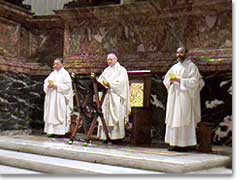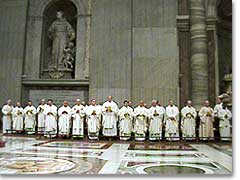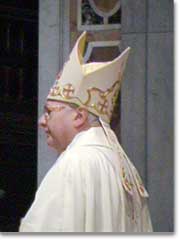 |
|
8 de diciembre de 2003: Misa en San Pedro, Roma December 8, 2003: Mass in St. Peter's, Rome 8. Dezember 2003: Festmesse im Petersdom |
|
 |
|
Mons. Dr.Robert Zollitsch, arzobispo de Friburgo, Alemania Archbishop Dr, Robert Zollitsch of Freiburg, Germany Erzbischof Dr. Robert Zollitsch, Freiburg |
|
 |
|
Concelebrantes principales: P. Heinrich Walter (der.), Mons. Robert Zollitsch, Mons. Peter Wolf (izq.) Main concelebrants: Fr. Heinrich Walter (r.), Archbishop Robert Zollitsch, Mons. Peter Wolf (l.) Konzelenbranten am Altar: P. Heinrich Walter (r.), Erzbischof Dr. Robert Zollitsch, Mons. Dr. Peter Wolf (l.) |
|
 |
|
Más de 50 sacerdotes en concelebración More than 50 concelebrating priests Über 50 Konzelebranten |
|
 |
|
P. Josef Grass, P. Mario Romero, P. Josef Fleischlin (de izq.) Fr. Joseph Grass, Fr. Mario Romero, Fr. Joseph Fleischlin (from left) P. Josef Grass, P. Mario Romero, P. Josef Fleischlin (von links) |
|
 |
|
Charla del Mons. Zollitsch Sermón of Mons. Zollitsch Predigt von Erzbischof Zollitsch |
|
 |
|
Antes de la bendición final Before the final blessing Vor dem Schluss-Segen Fotos: P. Marcelo Aravena © 2003 |
|
|
Rome. Early in the morning on 8 December 2003, the feast of our Lady and the day of the laying of the foundation stone of the shrine dedicated to Mary the Mother of the Church, the members of the Schoenstatt Family present in Rome gathered in St Peter’s Basilica for Holy Mass. More than 50 priests concelebrated with Archbishop Zollitsch, the Archbishop of Freiburg, at the Main Altar.
We publish the full text of Archbishop Zollitsch’s sermon
Dear Sisters, dear Brothers,
"Go into the Church," words spoken by our founder, Father Joseph Kentenich here in Rome, call again for a response from our Schoenstatt family today. As the Second Vatican Council was drawing to a close here in Rome, Father saw this as our great task. We have set out to follow this calling. So today we processed together into St Peter’s Basilica, to the grave of St Peter the Apostle and into the very heart of the Church. In spirit we are especially united with our holy Father at this time. According to our founder, our place is in the heart of the Church and this is, at the same time, our task.
As we entered the Basilica most of us probably noticed the great pillars lining the main nave, bearing the weight of the roof. We can see figures of saints on these pillars, and if you look more closely, you may discover that founders of religious orders in particular are represented, like St Dominic, St Ignatius or St Francis. Mentally we can extend this row of pillars today, to include the great founders of our time. These are the women and men who, through the ages of Church history right up until the present day, have inspired the Church through their communities. They have supported the Church and continue to do so, the same way as the pillars hold up this Basilica. This is what Father Kentenich saw as our mission: that we as the Schoenstatt family should carry the Church, and that we should take care that, more and more, the Church is transformed and becomes a real family as envisaged by the Second Vatican Council. In this way the Church will grow again, open up and fulfill her mission as leaven for the world.
A shrine in the centre of the Church
38 years ago today, the Second Vatican Council was concluded, here in St Peter’s. During the celebration Pope Paul VI referred expressly to Mary as the Mother of the Church. He invited Mary to be present in the midst of the successors of the Apostles and in the centre of the whole Church as she was at the first Pentecost in Jerusalem. Our founder made this plea of the Holy Father his own, he saw in it a message which was alive in him from the beginning of his work. This new Pentecost will become a reality when and where we take Mary as the Mother of the Church into our midst.
The symbol that we find on the foundation stone of the new shrine expresses this graphically: In the centre of the church there is a shrine. Wherever we enter a shrine, anywhere in the world, we find there our blessed Mother, the Mother of the Church, in union with her Son. That is the experience we bring to Rome. This is what we want to share especially with those responsible for our Church here in Rome. Furthermore, we want to share our experience with as many people as possible, here in the holy city and throughout the whole Church. The small shrine engraved on the foundation stone stands for the Mother of God. She should be at the centre of the Church. That little shrine on the foundation stone also stands for each of us. It symbolises that the Mother of God wants to work through us as the Mother of the Church.
Therefore, we want to look today especially to the Mother of God. Like our father and founder, we also want to invite our Lady to be present in our midst, in the centre of the Church, in our families and our personal lives. She, the great mother and educator, wants to transform us. On this feast day Mary stands before us as the Immaculata. She stands in the light of God, takes up the light of God and radiates it.
That the light of Christ will shine in the Church
High above us we can see the beautiful Holy Spirit window. As daylight approaches the light will shine through this window more and more and light up the church. We can see this window as a symbol of the Mother of God. The light that is given to her through the Holy Spirit shines through her. As Mother of the Church she takes care that the light of her Son can shine in the Church.
Mary herself also stands in this light. At the Annunciation she experienced a radical change in her life, as we have just heard in the gospel. In this moment in the light of God, she responds to the message of the angel with remarkable clarity and sense: "How can this be?" She can teach us to look at the big changes of our time, our Church and society with the same sense of clarity and pragmatism. Mary does not beat about the bush. That characterises Father Kentenich’s approach to Church and society as well. Let us ask our Lady and our founder to give us this pragmatism and clarity. Let us have courage and find the right words to speak.
Mary saw even more in the light of God. She could interpret the radical change in her life as a intervention of God: "Be it done to me according to your word". Mary recognised that God is in charge of her whole life. She wants to give us her perspective. The storms and upsets in society and in the church must not paralyse us. We cannot just stand still and mourn what has been. We must believe and trust that God is in charge of our lives. Our founder was deeply marked by this challenging confidence of our Lady. In this attitude Mary wants to be mother to us and the whole Church.
The light of Christ, which shines through her into the Church, needs to radiate anew into society. At the time of the Second Vatican Council much was said about the windows and doors of the Church which needed to be opened. The cares and anxieties of people today must be allowed in and accepted, they should find a home in the Church. The message of the Church, the good news, must flow into the world and transform it. This vision of the Council is a daily new reality in our shrines. Many people have found refuge in our shrines. This leads to our task, to open wide the doors of our hearts and our heart-shrines. To live the shrine means that we should take up the problems and needs of our neighbours, unselfishly, like Mary. Precisely those people who at first seem most alien to us should experience that they have a place in our hearts.
In this way a new community of faith can develop from heart to heart, our Church can radiate light and become a missionary Church. This is the perspective of our Lady. She who is so completely filled with the light of God does not just sit around, she goes out. She goes forth and takes her Son to the people, to Elizabeth. The intervention and irruption of God should motivate us to go out. Mary is the mother and image of the Church, which is missionary in a new way. Although just a girl, Mary sets off for the hill country of Judea full of confidence. There is much before us that looks like an uphill struggle. And yet there is the perspective of Mary, of the Council, of our founder: a perspective of going out and facing the challenge. Where we only see uphill, outside and often also inside our Church, we need to find our way step by step. This is the vision of our founder of the pilgrim Church. We should ask ourselves: Where can I start? To whom, or even more, with whom can I make a start? Where is the path by which I can take Christ to the people? It can start by telling one another about our journeys.
A shrine of new beginnings
Our Mater Ecclesia shrine is a shrine of new beginnings. In the last few months we have experienced that again. We should be thankful that this shrine is bringing about a sense of going forth in our Family. It is the kairos that we have received as a gift through the building of this shrine. At the same time the shrine challenges us to set out into the heart of the Church, it encourages us and gives us new strength. We can get moving in our everyday lives, wherever we are sent and everywhere we go, to be witnesses of God’s intervention.
Just as the light shines through the Holy Spirit window, and illuminates the basilica, so the light of God shines through Mary from our new shrine for our Church. Anyone can receive this light wherever they are. Then our new shrine will begin to grow in us and about us so that we can become more and more a living shrine for the Church and the world. Amen
Translation: Megan O'Brien, Levinia Pienaar, Cape Town, South Africa